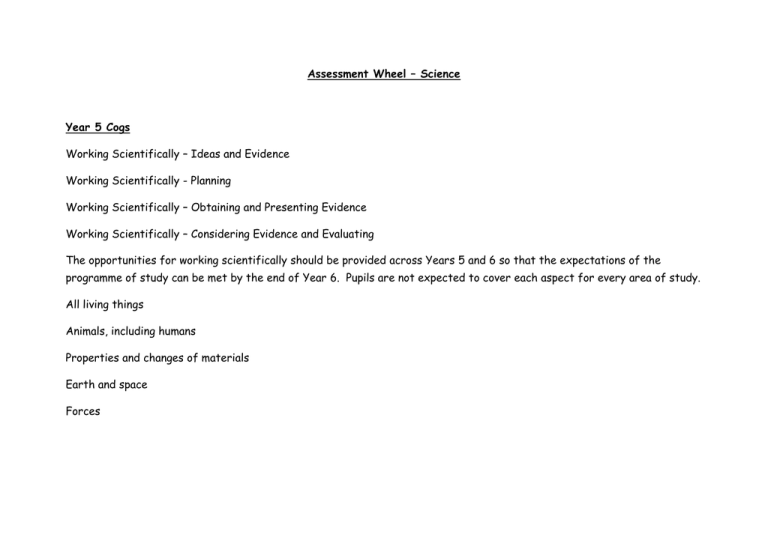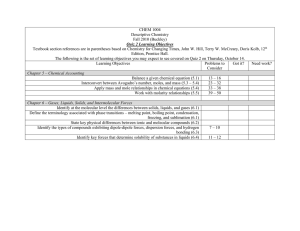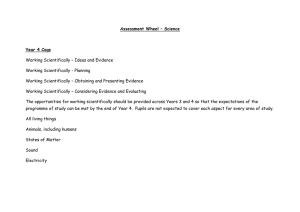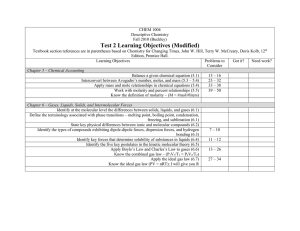Assessment Wheel – Science Year 5 Cogs
advertisement

Assessment Wheel – Science Year 5 Cogs Working Scientifically – Ideas and Evidence Working Scientifically - Planning Working Scientifically – Obtaining and Presenting Evidence Working Scientifically – Considering Evidence and Evaluating The opportunities for working scientifically should be provided across Years 5 and 6 so that the expectations of the programme of study can be met by the end of Year 6. Pupils are not expected to cover each aspect for every area of study. All living things Animals, including humans Properties and changes of materials Earth and space Forces YEAR 5 Working Scientifica lly Ideas and evidence W S Planning Experimen tal Work W S Obtaining and Presenting Evidence I can ask simple questions and recognising that they can be answered in different ways. I can identify and classify. I can perform simple tests using simple equipment, observing closely. I can gather and record data to help in answering questions. I can ask relevant questions and using different types of scientific enquiries to answer them. I can set up simple practical enquiries, comparative and fair tests making accurate and careful observations. I can gather, record, classify and present data in a variety of ways to help in answering questions. I can use simple models to describe scientific ideas.. I can take accurate measurements using standard unit. I can record findings using simple scientific language, drawings, labelled diagrams, keys, bar charts, and tables I can use test results to make predictions to set up further comparative and fair tests I can use a range of equipment, for example thermometers and data loggers. I can take measurements, using a range of scientific equipment, with increasing accuracy and precision. I can plan different types of scientific enquiries to answer questions. I can record data and results of increasing complexity using scientific diagrams and labels, classification keys, tables, bar and line graphs. I recognise and control variables where necessary. W S Considerin g Evidence and Evaluating I can use my observations and ideas to suggest answers to questions I can use results to draw simple conclusions and suggest improvements I can suggest new questions and predictions for new values in my results. I can identify differences, similarities or changes using my knowledge of scientific ideas and processes. . I can use straightforward scientific evidence to answer questions or to support their findings I can report and present findings from enquiries, including conclusions, causal relationships and explanation of results, in oral and written forms such as displays and other presentations. All living things I can observe and name parts of a flower. I can explain how pollen and seeds are dispersed. I can suggest come conditions to test when investigating germination I can name and explain functions of parts of a flower. I can describe the processes of pollination, fertilisation, seed dispersal and germination. I can describe the life process of reproduction in some plants and animals by studying my local environment over the course of the year. I can compare, contrast and explain the differences in the life cycles of a mammal, an amphibian, an insect and a bird Animals including Humans I recognise some stages in the development of humans. I can recognise the stages in the growth and development of humans. I can explain why it is important to use a number of seeds or plants in an investigation into growth or germination. I can explain why living things need to reproduce if the species is to survive. I can describe the changes as humans develop from birth to old age. I can identify scientific evidence that has been used to support or refute ideas or arguments. Properties and Changes in Materials I can compare and group together everyday materials based on evidence from comparative and fair tests, including their hardness, solubility, transparency, conductivity (electrical and thermal), and response to magnets. I can give reasons, based on evidence from comparative and fair tests, for the particular uses of everyday materials, including metals, wood and plastic. Which materials would be the most effective for making a warm jacket, for wrapping ice cream to stop it melting, or for making blackout curtains?’ They might compare materials in order to make a switch in a circuit. I can describe the differences between solids, liquids and gases. I can describe and explain the difference between melting and dissolving giving everyday examples of each. I know that gases flow from place to place and that air is a mixture of gases. I know that liquids evaporate to form gas. I can make clear distinctions between the properties of solids, liquids and gases. I know that some materials need to be heated to a very high temperature in order to melt or evaporate. I can name some materials that will dissolve in water. I understand that although it is not possible to see a dissolved solid it remains in the solution. I know that solids can be recovered from a solution by evaporation. I can explain that when solids dissolve they can break up so small they can pass through the holes in filter paper. I can identify several factors that affect the rate at which a solid dissolves. How does temperature affect how quickly sugar dissolves? I use knowledge of solids, liquids and gases to decide how mixtures might be separated, including through filtering, sieving and evaporating. I can demonstrate that dissolving, mixing and changes of state are reversible changes. I can classify some changes as reversible and some as irreversible. Under what conditions will water evaporate quickly? I can explain that some changes result in the formation of new materials, and that this kind of change is not usually reversible, including changes associated with burning and the action of acid on bicarbonate of soda. I understand that some irreversible changes make now and useful materials. I can use evidence to explain that in some cases the new materials made are gases. I understand the formation of a gas signifies an irreversible change. Use burning candles to show irreversible change taking place. Model the gas from a blown out candle can be relit. A gas has been formed in the melting and I can find out about how chemists create new materials, for example Spencer Silver, who invented the glue for sticky notes or Ruth Benerito, who invented wrinkle-free cotton. I can research and discuss how chemical changes have an impact on our lives, for example cooking, and discuss the creative use of new materials such as polymers, supersticky and super-thin materials. evaporation of candle wax and it is this that burns. Introduce safety and fire triangle. What are the factors that affect the burning candle? Earth and Space I know that the Earth, Sun and Moon are spherical in shape. I can observe and describe how shadows change as the Sun appears to move across the sky. I can describe the movement of the Earth, and other planets, relative to the Sun in the solar system. I know the 8 planets of our solar system and their order from the Sun. Forces I can explain that unsupported objects fall towards the Earth because of the force of gravity acting between the Earth and the falling object. I know that friction is a force. I can describe some ways friction can be increased between solid surfaces. I know that the rotation of the Earth causes shadows to change through the day and causes the Sun to appear to be moving I can use the idea of the Earth’s rotation to explain day and night. I understand that it is only daylight on the side of the Earth facing the sun. I can describe some of the factors that increase air and water resistance. I can measure forces using a forcemeter. I know that force is measured in Newtons. I know the Moon orbits the Earth. I know that a moon is a celestial body that orbits a planet (Earth has one moon; Jupiter has four large moons and numerous smaller ones). I understand that the appearance of the Moon changes over 28 days due to it’s orbiting of the earth. I can identify the effects of air resistance, water resistance and friction, acting between moving surfaces. I can identify when frictional forces are helpful. I can name situations when I understand that force and motion can be transferred through mechanical devices such as gears, pulleys, levers and springs. I can research the use of these devices through history and I know that ideas about the solar system have developed over time by considering the work of scientists such as Ptolemy, Alhazen and Copernicus. frictional forces resist motion. design and make an artefact that uses simple levers, pulleys, gears and/or springs and explore their effects.





